What’s Teaching Portoflio?
Here, you can learn about Teaching Portfolio, Teaching Portfolio Chart, and Teaching Statement. These differ in terms of the format, volume, depth of reflection, and time required for creation.
Please choose the one that best aligns with your purpose.
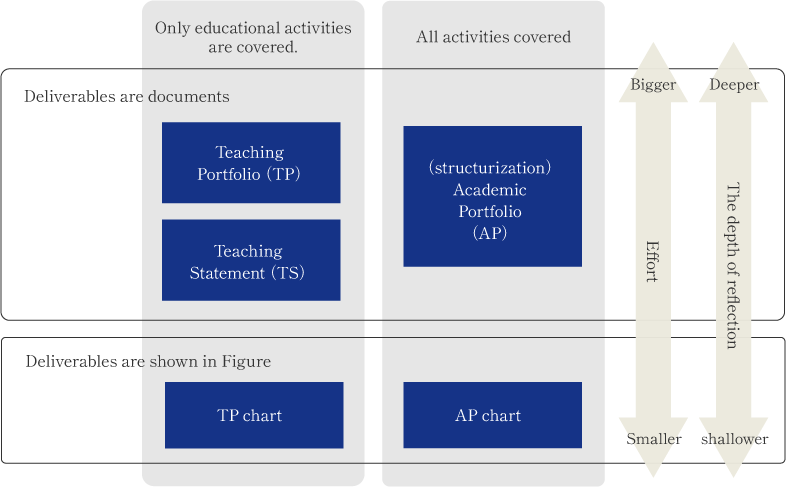
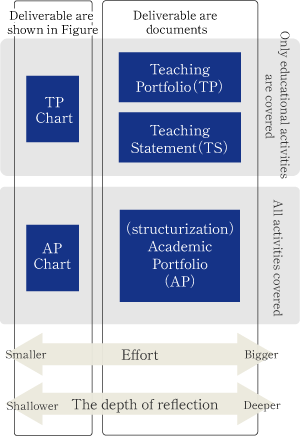
Teaching Portfolio
Teaching Portfolio is “a coherent and selected document that carefully reflects on one’s own teaching performance with solid evidence to support the satements.”
Paper-based Teaching Portfolios are approximately 8-10 pages long with supporting materials attached to the main text.
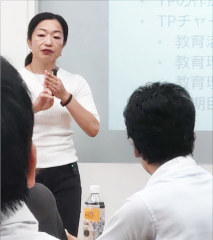
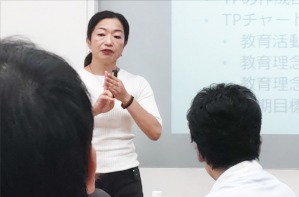
Purpose
The Teaching Portfolio serves two primary purposes: improvement of teaching and visualization of teaching performance.
During the process of developing your Teaching Portfollio, clarifying the underlying principles and philosophies behind teaching activities allows you to reassess their activities based on these principles.
This helps identify discrepancies or deficiencies between your personal philosophies and actual practices. Furthermore, setting these solutions as goals becomes a crucial step toward improvement.
Additionally, the Teaching Portfolio serves as a document that visualizes teaching activities.
It follows a consistent structure, including philosopies, strategies, and methodogies. Rather than merely listing facts, it allows for the description of activity features and strengths in your own words, enabling an assessment of the “quality” of teaching activities.
Supporting evidence ensures the fairness of evaluating teaching achievements.
Structure
The Teaching Portfolio will consist of the following items.
These will be described in your own words to ensure consistency.
Teaching responsibilities(what are you doing?)
Philosophy(why are you doing them?)
Strategies and methods(how are you doing them)
Outcomes(how did you do them)
Future goals(what you want to achieve in the future)
As a table of contents, you are free to set it up as you see fit for your activities, and you can also add items other than these, such as improvements you have made or matters related to your research.
How to Develop
The general flow of the process is that you become aware of your philosophy by listing your daily teaching activities and considering the reasons behind the specific behaviors and methodologies you are taking, and then organise your entire activities around that philosophy and set goals for the future.
Instead of thinking about the philosophy out of the blue, the process starts with your reflection on your daily activities.
It takes about 13-17 hours to develop your Teaching Portfolio with careful reflection.
It is possible to develop your Teaching Portfolio by yourself, but for deeper reflection and easier development, it is recommended to participate in a short-term intensive workshop and have a mentor (support person) accompany you while developing your Teaching Portfolio. For more information, see the explanation on Teaching Portfolio in ‘
How to Develop‘.
How to Use
Teaching Portfolios created may be used in the following ways.
– To refer to it as a guide for improving your own teaching.
– To share the philosophy part and so on with students and make use of it to create a better learning environment.
– To submit it as an evaluation document for teaching performance (recruitment and promotion).
– To share outstanding performances (selection materials for the Outstanding Teacher Award, information sharing within the department).
– To share excellent activities (materials for selection for the Outstanding Teacher Award, information sharing within the department).
– To summarise your teaching and pass it on to future generations (Legacy Portfolio).

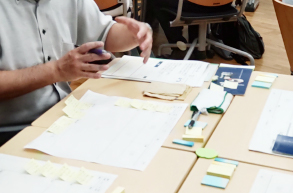
Update
For improving your teaching, it is advisable to review your short-term goals on an annual basis.
It is also a good time to update before and after a change of environment, such as taking on a new class.
Furthermore, before or after a promotion or a change of affiliation is also a good time to update your current and future path in the sense that you can define it yourself.
Updating is not easy to do on your own. You should find an update workshop.
References
For more information on Teaching Portfolio, please see the following resources.
Seldin, Peter, Miller, J. Elizabeth, Seldin, Clement A., McKeaches, Wilbert James (2010) The Teaching Portfolio: A practical guide to improved performance and promotion/tenure decisions 4th ed. Jossey bass Inc Pub.
Kayoko Kurita (2020) The teaching portfolio as a method for evaluating the educational performance of university teachers, University Evaluation Review, 19, 55-64. (In Japanese)


TP Chart
What is Teaching Portfolio Chart?
Teaching Portfolio Chart (TP Chart) is a worksheet that organises the process of developing a Teaching Portfolio so that it can be tackled step by step.
It was originally developed to provide hands-on experience in Teaching Portfolio development.
Purpose
TP Chart is created for the purpose of improving teaching.
It can also be used as a communication tool to share TP Charts in progress or completed with others, creating a forum for mutual understanding and learning from each other’s teaching.
Structure
TP Chart is a worksheet in which the following items, which are the same as Teaching Portfolio, are arranged in framed sections.
– Responsibility
– Philosophy
– Strategy and Methodology
– Outcome and Evaluation
– (Improvement and effort)
– Goals
For each item, write the specific elements on a sticky.
How to Develop
You can develop your TP Chart by yourself, but for deeper reflection and easier development, we recommend participating in a workshop.
For more information about the workshop, see the explanation in the ‘How to Develop’ section.
How to Use
Teaching Portfolios created may be used in the following ways.
– To refer to it as a guide for improving your own teaching.
– To share the philosophy part and so on with students and make use of it to create a better learning environment.
– To reflect briefly on your own teaching as a preliminary to making a Teaching Portfolio.
– To explain your TP Chart to others in order to broaden your perspectives on teaching philosophy and methodologies and to deepen their understanding of each other’s teaching and yourselves.
Update
The timing of updates is basically the same as for Teaching Portfolios, so for more information, refer to the update section of Teaching Portfolio.
TP Chart is a single worksheet, so it can be reviewed more easily than Teaching Portfolio. In particular, if the ‘short-term goals’ indicated on the blue stickies have been achieved, you can update them by replacing them with yellow stickies.
As with Teaching Portfolio, updating is not easy to do on your own, so it is a good idea to participate again in a workshop on developing your TP Chart or to update it twith others.
References
For more information on TP Chart, please see the following resources (All are in Japanese).
Kayoko Kurita and Lui Yoshida (2020) Development and Evaluation of a Teaching Portfolio Chart and a Workshop in its Creation for the Purpose of Reflection on Teaching Activities, Educational Development Studies,1, 19-27. (In Japanese) https://doi.org/10.57294/jaed.1.0_19
・栗田佳代子・吉田塁(2021)「リフレクションを可視化するティーチング・ポートフォリオ・チャート作成講座」医学書院. (In Japanese) ISBN 978-4-260-04477-6
・栗田佳代子、 吉田塁、大野智久 (2018) 「教師のための『なりたい教師』になれる本!」学陽書房. (In Japanese) ISBN 9784313653429


What is Teaching Statement?
Teaching Statement is a simplified version of Teaching Portfolio.
A paper Teaaching Statement is about 1-3 pages in length, so the smaller volume makes it less labour intensive to develop than Teaching Portfolio.
If Teaching Statement is accompanied by evidence, it can have the same functionality as Teaching Portfolio.
When you want all colleagues to prepare the documents promptly, it is more practical to implement Teaching Statement than Teaching Portfolio.
Purpose
As with Teaching Portfolio, the purpose is to improve teaching and visualise teaching outcomes.
During the development process, you look back at your teaching activities and find out for yourself what is important (philosophy).
Various realisations and future goal setting in this process of reconsidering your teaching will lead to improvements. In addition, the document that takes shape as an outcome makes teaching performance visible.
Sturcture
Teaching Statement, like Teaching Portfolio, consists of the following items, which are described in your own words so that they are consistent.
– Responsibility
– Philosophy
– Strategy and Methodology
– Outcome and Evaluation
– (Improvement and effort)
– Goals
How to Develop
Assuming that your TP Chart has already been developed, this TP Chart is put into writing.
You can develop your TP Chart by yourself, but for deeper reflection and easier creation, we recommend that you participate in a one-day workshop and have a mentor (a support person) accompany you while you develop your Teaching Statement.
For more information, see the explanation on TS in ‘How to Develop’.
How to Use
Teaching Statement you have developed may be used in the same way as Teachig Portfolio, but as it is small in volume, it may not be sufficient to be used as a rigorous performance evaluation document.
On the other hand, they may be easy to read for dissemination outside the university.
– To refer to it as a guide for improving your own teaching.
– To share the philosophy part and so on with students and make use of it to create a better learning environment.
– To submit it as an evaluation document for teaching performance (recruitment and promotion).
– To share outstanding performances (selection materials for the Outstanding Teacher Award, information sharing within the department).
– To share excellent activities (materials for selection for the Outstanding Teacher Award, information sharing within the department).


